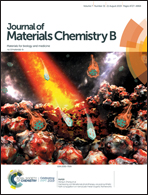Light-activated drug release from a hyaluronic acid targeted nanoconjugate for cancer therapy†
Abstract
Hyaluronic acid (HA)-based nanocarriers are of great interest in the drug delivery field due to the tumor targetability via CD44-mediated recognition and endocytosis. However, sufficient tumor-specific release of encapsulated cargoes with steady controllability is necessary to optimize their outcome for cancer therapy. In this study, we constructed a light-activated nanocarrier TKHCENPDOX to enable on-demand drug release at the desired site (tumor). Particularly, TKHCENPDOX encapsulating doxorubicin (DOX) was self-assembled from a HA-photosensitizer conjugate (HA-TK-Ce6) containing reactive oxygen species (ROS)-sensitive thioketal (TK) linkers. Following i.v. injection, TKHCENPDOX was accumulated in the MDA-MB-231 breast tumor xenograft more efficiently through preventing drug leakage in the bloodstream and the HA-mediated targeting effect. Upon internalization into tumoral cells, 660 nm laser irradiation generated ROS during a photodynamic (PDT) process to cleave the TK linker next to Ce6, resulting in light-induced TKHCENPDOX dissociation and selective DOX release in the tumor area. Consequently, TKHCENPDOX showed a remarkable therapeutic effect and minimized toxicity in vivo. This strategy might provide new insight for designing cancer-selective nanoplatforms with active targeting and locoregional drug release simultaneously.



 Please wait while we load your content...
Please wait while we load your content...